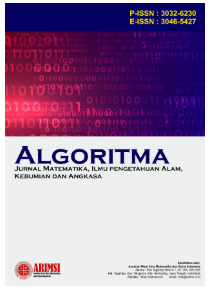Compare Between Kriging And Fuzzy kriging (Centroid Method) With Application
DOI:
https://doi.org/10.62383/algoritma.v3i3.496Keywords:
Kriging, abu vulkanik, Centroid methodAbstract
This research deals with a comparison of Kriging's method in predicting ordinary and fuzzy data in order to know the best method for future studies. Ordinary data was used in the field of depth of groundwater wells for 37 locations in Kirkuk city, and these data were fuzzy into fuzzy numbers of the trigonometric type that have a function of belonging, Then the centroid of each fuzzy number was found for the purpose of facilitating the calculations. An unknown point was predicted for both the ordinary and fuzzy data. After comparing the results with a standard of least variance, it was found that the fuzzy data had better results than the ordinary data.
Downloads
References
Bardossy, A., Bogardi, I., & Kelly, W. E. (1990). Kriging with imprecise (fuzzy) variograms. I: Theory. Mathematical Geology, 22, 63–79.
Bohling, G. (2005). Introduction to geostatistics and variogram analysis (Vol. 1). Kansas Geological Survey.
Chichan, A. M. A., Fakhri, M. A., & Najim, Z. (2021). Comparison between iterative maximum likelihood estimators method and Bayesian method for estimating logistic regression model parameters with practical application. Journal of Economics and Administrative Sciences, 10(2), 259–270. Published by Kirkuk University.
Guo, D., Guo, R., & Thiart, C. (2003). Integrating GIS with fuzzy logic and geostatistics: Predicting air pollutant PM10 for California, using fuzzy kriging (Master’s thesis). [Institution not specified].
Hesamian, G., & Akbari, M. G. (2020). A kriging method for fuzzy spatial data. International Journal of Systems Science, 51(11), 1945–1958.
Lee, K. H. (2004). First course on fuzzy theory and applications (Vol. 27). Springer Science & Business Media.
Mohammed, J. M., Tawfeeq, A. F., & Aziz, M. M. (2022). Maximum likelihood for fuzzy pure spatial autoregressive model. International Journal of Nonlinear Analysis and Applications, 13(1), 2267–2277.
Nielsen, A. A. (2009). Geostatistics and analysis of spatial data. Informatics and Mathematical Modelling, Technical University of Denmark, DTU, 7–12.
Quevedo, J. R. N. (2017). Fuzzy sets: A way to represent ambiguity and subjectivity. Boletín de Matemáticas, 24(1), 57–89.
Ross, T. J. (2005). Fuzzy logic with engineering applications. John Wiley & Sons.
Smith, T. E. (2015). Spatial data analysis. University of Pennsylvania, School of Engineering and Applied Science. [email protected]
Studzinski, J. (2011). Application of kriging algorithms for solving some water nets management tasks. In EnviroInfo (pp. 477–488).
Zhang, A. (2016). Statistical analysis of fuzzy linear regression model based on centroid method. Applied Mathematics, 7(7), 579–586.
Downloads
Published
How to Cite
Issue
Section
License
Copyright (c) 2025 Algoritma : Jurnal Matematika, Ilmu pengetahuan Alam, Kebumian dan Angkasa

This work is licensed under a Creative Commons Attribution-ShareAlike 4.0 International License.





